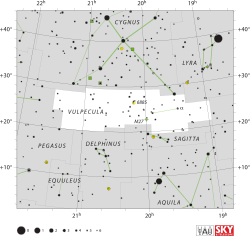QR Vulpeculae
| QR Vulpeculae | |
 | |
| Observationsdata Epok: J2000.0 | |
|---|---|
| Stjärnbild | Räven |
| Rektascension | 20t 15m 15,89542s[1] |
| Deklination | +25° 35′ 31,0549″[1] |
| Skenbar magnitud () | 4,60 - 4,80[2] |
| Stjärntyp | |
| Spektraltyp | B3 V[3] |
| U–B | -0,73[4] |
| B–V | -0,18[4] |
| Variabeltyp | Gamma Cassiopeiae-variabel[2] |
| Astrometri | |
| Radialhastighet () | -7,00[5] km/s |
| Egenrörelse (µ) | RA: +6,93[1] mas/år Dek.: -3,89[1] mas/år |
| Parallax () | 3,29 ± 0,51[1] |
| Avstånd | ca 1 000 lå (ca 300 pc) |
| Absolut magnitud () | -2,56[6] |
| Detaljer | |
| Massa | 8,0[7] M☉ |
| Luminositet | 3 331[6] L☉ |
| Temperatur | 18 700[8] K |
| Metallicitet | -0,10[9] |
| Vinkelhastighet | 160[10] km/s |
| Andra beteckningar | |
| CCDM J20153+2536AB, AG+25 2303, AKARI-IRC-V1, J2015158+253530, BD+25 4165, GSC 02159-02068, HD 192685, HIC 99824, HIP 99824, HR 7739, IRAS 20131+2526, 2MASS J20151589+2535310, PPM 110743, SAO 88410, TD1 26365, TYC 2159-2068-1, UCAC4 578-103211, uvby98 100192685 ABV, QR Vulpeculae, WDS J20153+2536AB, WISE J201515.89+253530.9, Gaia DR2 1835335977682835200, Gaia DR3 1835335977682835200[11] | |
QR Vulpeculae eller HD 192685, är en ensam stjärna belägen i den mellersta delen av stjärnbilden Räven. Den har en skenbar magnitud som varierar 4,60 - 4,80[2] och är svagt synlig för blotta ögat där ljusföroreningar ej förekommer. Baserat på parallaxmätning inom Hipparcosuppdraget på ca 3,29 mas,[2] beräknas den befinna sig på ett avstånd på ca 1 000 ljusår (300 parsek) från solen. Den rör sig närmare solen med en heliocentrisk radialhastighet på ca -7 km/s.[5]
Observation[redigera | redigera wikitext]
Från oktober till december 1982 ökade Hα-absorptionslinjen i emissionsstyrka med 30 procent[12] Linjen är delvis fylld av rödförskjuten emission.[13]
Egenskaper[redigera | redigera wikitext]
QR Vulpeculae A är en blå stjärna i huvudserien av spektralklass B3 V.[3] Den har en massa som är ca 8[7] solmassor och utsänder från dess fotosfär energi motsvarande 3 330[6] gånger solen vid en effektiv temperatur av ca 18 700 K.[8] Stjärnan har överskott av infraröd strålning (12-100 μm) som tolkas som fri strålning i gasen som omger stjärnan.[14]

QR Vulpeculae varierar något i ljusstyrka och klassificeras som en Gamma Cassiopeiae-variabel.[2]
QR Vulpeculae har minst en följeslagare separerad med 0,55 bågsekund och har skenbar magnitud 7,55,[16] och kan också vara en långperiodisk spektroskopisk dubbelstjärna.[17]
Referenser[redigera | redigera wikitext]
- Den här artikeln är helt eller delvis baserad på material från engelskspråkiga Wikipedia, 25 februari 2023..
Noter[redigera | redigera wikitext]
- ^ [a b c d e] Van Leeuwen, F. (2007). "Validation of the new Hipparcos reduction". Astronomy and Astrophysics. 474 (2): 653–664. arXiv:0708.1752. Bibcode:2007A&A...474..653V. doi:10.1051/0004-6361:20078357. S2CID 18759600. Vizier catalog entry
- ^ [a b c d e] Samus, N. N.; Durlevich, O. V.; et al. (2009). "VizieR Online Data Catalog: General Catalogue of Variable Stars (Samus+ 2007-2013)". VizieR On-line Data Catalog: B/GCVS. Originally Published in: 2009yCat....102025S. 1. Bibcode:2009yCat....102025S.
- ^ [a b] Walker, G. A. H.; Yang, S.; Witt, A. N.; Fahlman, G. G. (Aug–Sep 1980). "The extinction of HD 200775 by dust in NGC 7023". Publications of the Astronomical Society of the Pacific. 92: 414. Bibcode:1980PASP...92..411W. doi:10.1086/130687.
- ^ [a b] Mermilliod, J. C. (2006). "VizieR Online Data Catalog: Homogeneous Means in the UBV System (Mermilliod 1991)". VizieR On-line Data Catalog: II/168. Originally Published in: Institut d'Astronomie. 2168. Bibcode:2006yCat.2168....0M.Vizier catalog entry
- ^ [a b] Gontcharov, G. A. (2006). "Pulkovo Compilation of Radial Velocities for 35 495 Hipparcos stars in a common system". Astronomy Letters. 32 (11): 759–771. arXiv:1606.08053. Bibcode:2006AstL...32..759G. doi:10.1134/S1063773706110065. S2CID 119231169.
- ^ [a b c] Anderson, E.; Francis, Ch. (2012). "XHIP: An extended hipparcos compilation". Astronomy Letters. 38 (5): 331. arXiv:1108.4971. Bibcode:2012AstL...38..331A. doi:10.1134/S1063773712050015. S2CID 119257644. Vizier catalog entry
- ^ [a b] Tetzlaff, N.; Neuhäuser, R.; Hohle, M. M. (2011). "A catalogue of young runaway Hipparcos stars within 3 kpc from the Sun". Monthly Notices of the Royal Astronomical Society. 410 (1): 190–200. arXiv:1007.4883. Bibcode:2011MNRAS.410..190T. doi:10.1111/j.1365-2966.2010.17434.x. S2CID 118629873. Vizier catalog entry
- ^ [a b] Hohle, M.M.; Neuhäuser, R.; Schutz, B.F. (2010). "Masses and luminosities of O- and B-type stars and red supergiants". Astronomische Nachrichten. 331 (4): 349. arXiv:1003.2335. Bibcode:2010AN....331..349H. doi:10.1002/asna.200911355. S2CID 111387483. Vizier catalog entry
- ^ Wu, Yue; Singh, H. P.; Prugniel, P.; Gupta, R.; Koleva, M. (2010). "Coudé-feed stellar spectral library – atmospheric parameters". Astronomy & Astrophysics. 525: A71. arXiv:1009.1491. Bibcode:2011A&A...525A..71W. doi:10.1051/0004-6361/201015014. S2CID 53480665.
- ^ Abt, Helmut A.; Levato, Hugo; Grosso, Monica (2002). "Rotational Velocities of B Stars". The Astrophysical Journal. 573 (1): 359–365. Bibcode:2002ApJ...573..359A. doi:10.1086/340590.
- ^ HD 192685 (unistra.fr). Hämtad 2024-02-16.
- ^ [a b] Lefèvre, L.; Marchenko, S. V.; Moffat, A. F. J.; Acker, A. (November 2009). "A systematic study of variability among OB-stars based on HIPPARCOS photometry". Astronomy and Astrophysics. 507 (2): 1141–1201. Bibcode:2009A&A...507.1141L. doi:10.1051/0004-6361/200912304.
- ^ Green, Daniel W. E. (July 14, 1982). "2 Vul AND HR 7739". IAU Circular. IAU Central Bureau for Astronomical Telegrams. 3710. Hämtad 11 december 2012.
- ^ Cote, J. (July 1987). "B and A type stars with unexpectedly large colour excesses at IRAS wavelengths". Astronomy and Astrophysics. 181 (1): 83. Bibcode:1987A&A...181...77C. ISSN 0004-6361.
- ^ Pavlovski, K.; Bozic, H.; Harmanec, P.; Horn, J.; Koubsky, P. (14 November 1983). "Sudden Brightening of the Recently Discovered Be Star HR 7739". Information Bulletin on Variable Stars. 2431 (1): 1. Bibcode:1983IBVS.2431....1P. ISSN 0374-0676.
- ^ Eggleton, P. P.; Tokovinin, A. A. (2008). "A catalogue of multiplicity among bright stellar systems". Monthly Notices of the Royal Astronomical Society. 389 (2): 869. arXiv:0806.2878. Bibcode:2008MNRAS.389..869E. doi:10.1111/j.1365-2966.2008.13596.x. S2CID 14878976. Vizier catalog entry
- ^ Mason, Brian D.; Wycoff, Gary L.; Hartkopf, William I.; Douglass, Geoffrey G.; Worley, Charles E. (2001). "The 2001 US Naval Observatory Double Star CD-ROM. I. The Washington Double Star Catalog". The Astronomical Journal. 122 (6): 3466. Bibcode:2001AJ....122.3466M. doi:10.1086/323920. Vizier catalog entry





